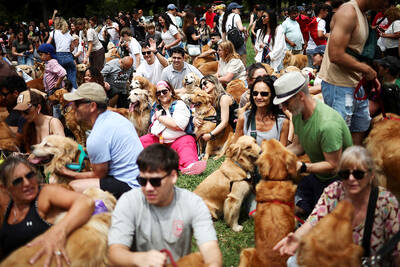When Kiyoshi Amemiya first saw the gruesome effects of landmines while on a business trip to Cambodia in 1994 he was, like most visitors to the killing fields before him, deeply shocked.
The successful businessman returned to Japan but the images of mine victims with mutilated limbs were seared indelibly onto his brain. So he resolved to do something.
Ameniya, now 57, had no experience of weaponry or warfare. All he did have was the resources of the company he runs, which distributes construction machinery made by a subsidiary of industrial giant Hitachi in central Japan.
Ten years on, he is the inventor of the country's first anti-personnel landmine-disposal machine, and is helping clear the deadly invisible enemy from Afghanistan to Nicaragua.
"It was just too shocking," he says in an interview at his company offices, thinking back to his experience in Cambodia, one of the world's most heavily mined countries.
"I saw women and children with missing arms and legs and many had severe facial burns. Although I knew nothing about landmines then, I was determined to do something about it," he said.
In 1995, Amemiya, president of Yamanashi Hitachi Construction Machinery, set up a six-member project team within the company to begin the development of a mine-clearing machine.
What they came up with was, essentially, a converted mechanical digger. Amemiya said he made the mine clearer by adapting Hitachi Construction's hydraulic excavator, putting a drum bristling with blades in place of the bucket on the hydraulic arm and strengthening the cab against blasts.
"The most difficult part was creating steel `teeth' that could resist the 1,000-degree heat from a mine explosion. It took us four to five years to make the strong cutters," he said.
The team attached 40 such digging blades around a steel drum and fitted it to the hydraulic arm. By lowering the arm to the ground in front of the vehicle rotating the drum, the machine sets off anti-personnel mines and can withstand up to 10,000 explosions.
"It is 100 times faster than removing landmines by hand," he said, adding it cost the company ?100 million (US$943,000) to develop the machine.
Amemiya has donated a total of 36 machines to Afghanistan, Cambodia, Nicaragua, Thailand and Vietnam through the UN and local non-governmental organizations, paid for with profits from the company's commercial operations.
"In Cambodia and Vietnam, mined areas are often covered in dense trees and bushes, but our blades can cut them before disposing of the landmines," he said.
"For Afghanistan, we made the blades strong enough to resist sand and rocks while in Nicaragua we had to adjust the blades so that they could work in mud," he said.
The machine has a one-man cab, protected by special tempered glass but it can also be operated by remote control.
After the mine explodes, the metal fragments are collected with a magnet and the machine can also plow the ground and even sprinkle fertilizer.
The mine clearer's reputation for doing its vital task well eventually reached the Indian Defense Ministry, which asked Amemiya to sell it, while the US Defense Department inquired about it.
But Amemiya rejected both offers.
"I have no business with the military," he said.
Last December, Amemiya developed an upgraded machine capable of clearing anti-tank landmines, with government help worth ?56 million for the first time.
The new machine, which also features a mine detector, has a pivot with 42 chains attached. Each chain ends in a 2kg steel cube. Once the pivot rolls, the chains and the cubes flail the ground, blowing up anti-tank mines.
The company is to ship the new machine to Afghanistan at the end of this month and Amemiya is scheduled to visit the country in June to instruct Afghan mine clearers in using it.
An estimated 5 million to 7 million mines are scattered throughout Afghanistan, according to the UN -- while an estimated 110 million landmines are strewn in more than 70 countries, killing and maiming 20,000 each year.
Amemiya said his next goal was to create a machine that clears unexploded ordnance.
"Clearing unexploded ordnance is extremely difficult and dangerous for local mine clearers. But I'm already working on it and I am tenacious. I will not give up on clearing landmines from the world," he said.

PARLIAMENT CHAOS: Police forcibly removed Brazilian Deputy Glauber Braga after he called the legislation part of a ‘coup offensive’ and occupied the speaker’s chair Brazil’s lower house of Congress early yesterday approved a bill that could slash former Brazilian president Jair Bolsonaro’s prison sentence for plotting a coup, after efforts by a lawmaker to disrupt the proceedings sparked chaos in parliament. Bolsonaro has been serving a 27-year term since last month after his conviction for a scheme to stop Brazilian President Luiz Inacio Lula da Silva from taking office after the 2022 election. Lawmakers had been discussing a bill that would significantly reduce sentences for several crimes, including attempting a coup d’etat — opening up the prospect that Bolsonaro, 70, could have his sentence cut to

China yesterday held a low-key memorial ceremony for the 1937 Nanjing Massacre, with Chinese President Xi Jinping (習近平) not attending, despite a diplomatic crisis between Beijing and Tokyo over Taiwan. Beijing has raged at Tokyo since Japanese Prime Minister Sanae Takaichi last month said that a hypothetical Chinese attack on Taiwan could trigger a military response from Japan. China and Japan have long sparred over their painful history. China consistently reminds its people of the 1937 Nanjing Massacre, in which it says Japanese troops killed 300,000 people in what was then its capital. A post-World War II Allied tribunal put the death toll

A passerby could hear the cacophony from miles away in the Argentine capital, the unmistakable sound of 2,397 dogs barking — and breaking the unofficial world record for the largest-ever gathering of golden retrievers. Excitement pulsed through Bosques de Palermo, a sprawling park in Buenos Aires, as golden retriever-owners from all over Argentina transformed the park’s grassy expanse into a sea of bright yellow fur. Dog owners of all ages, their clothes covered in dog hair and stained with slobber, plopped down on picnic blankets with their beloved goldens to take in the surreal sight of so many other, exceptionally similar-looking ones.

‘UNWAVERING ALLIANCE’: The US Department of State said that China’s actions during military drills with Russia were not conducive to regional peace and stability The US on Tuesday criticized China over alleged radar deployments against Japanese military aircraft during a training exercise last week, while Tokyo and Seoul yesterday scrambled jets after Chinese and Russian military aircraft conducted joint patrols near the two countries. The incidents came after Japanese Prime Minister Sanae Takaichi triggered a dispute with Beijing last month with her remarks on how Tokyo might react to a hypothetical Chinese attack on Taiwan. “China’s actions are not conducive to regional peace and stability,” a US Department of State spokesperson said late on Tuesday, referring to the radar incident. “The US-Japan alliance is stronger and more